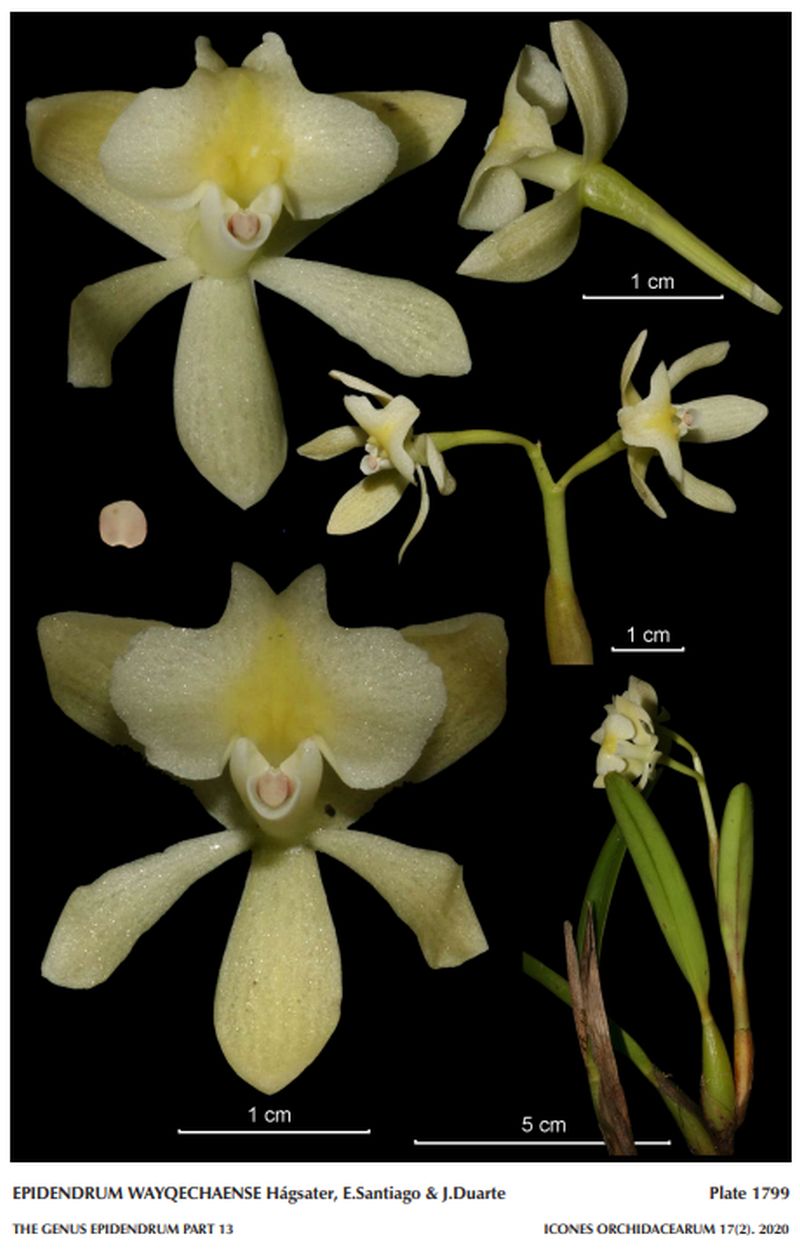

Epidendrum wayqechaense Hágsater, E.Santiago & J.Duarte 2020 GROUP Saxicola
TYPE LCDP Photo by R. Repasky & A. Cisneros/ TYPE photo by R. Repasky and The AMO Herbario Website



Common Name The Wayqecha Epidendrum [In reference to the Wayqecha, Cloud Forest Research Station, where the species has been collected, though a bird observation station and lodge, it is found at the edge of the Manú National Park Biosphere Reserve which has important plant diversity. Wayqecha in the Quechua language translates as “small friend"]
Flower Size 1.2" [3 cm]
Found in Cusco department of Peru in the Kosñipata Valley, between Paucartambo and Pillcopata at elevations around 2958 meters as a miniature sized, cold growing epiphyte with thickened, forming fusiform, striated and rugose, pale green pseudobulbs, covered by a single, membranaceous, brown, scarious and becoming fibrous with age sheath and carrying a single apical, pale green, articulate, coriaceous, the ventral surface rugose, narrowly oblong, apex rounded, minutely apiculate, margin entire leaf that blooms in the spring on a terminal, arising through a single tubular, oblong, conduplicate, apex obtuse, yellow-brown spathe, peduncle 1.72" [4.2 cm] long, terete, thin, erect, straight, yellowish green, rachis .2" [5 mm] long, 2.8 to 3" [7.0 to 7.5 cm] long overall, apical, erect, racemose, simultaneously 2 flowered inflorescence with much shorter than the ovary, triangular-ovate, acute, embracing floral bracts and carrying non-resupinate, creamy white flowers with the disc of the lip with a pale yellow spot that disappears before reaching the apical sinus and the fragrance was not recorded.
"Epidendrum wayqechaense belongs to the GROUP Saxicola characterized by the pseudobulbous stems, caespitose or scandent habit, the prominent spathaceous bract apically rounded, few-flowered, erect inflorescence, the flowers purple or yellow, and the surface of the vegetative structures often rugose. The new species is recognized by the 2-flowered inflorescence with creamy-white flowers and a yellow spot on the disc of the lip; sepals .52" [13 mm] long, petals .52 x .1" [13 x 2.5 mm], narrowly spatulate-oblanceolate, lip 3-lobed, with the mid-lobe sub-quadrate when spread, in natural position appearing emarginate, as if formed by two triangular lobes. It is similar to Epidendrum microcattleyioides which has 4 yellow flowers, sepals .46 to .48" [11.5 to 12.0 mm] long, petals .44 x .26" [11 x 6.5 mm], obovate-spatulate, a lip entire, reniform with the apex widely emarginate. Epidendrum herreranum C.Schweinf. has yellow flowers, tinged orange to reddish bronze, sepals .72 to .94" x .28 to .4" [18.0 to 23.5 x 7.0 to 10.0 mm], ovate-elliptic, petals .68 to .92" x .2 to .4" [17 to 23 x 5.0 to 10.0 mm], obovate-spatulate, and the mid-lobe of the lip an inverted “T”, apex forming two divaricate lobes which overlap with the corners of the lateral lobes. Epidendrum tetartociclium Collantes & Hágsater has pale green to creamy green sepals, translucid to somewhat opaque, petals and lip creamy green to citrus yellow, sepals 1 to 1.04" [25 to 26 mm] long, elliptic, and petals .96 x .32" [24 x 0.8 mm], oblong-elliptic to oblong-obtrullate. Epidendrum repaskyae Hágsater, E.Santiago & J.Duarte has 3 to 4 creamy white flowers, the sepals and petals forming a cup, sepals .44" [11 mm] long, petals .4 x .2" [10 x 5 mm], elliptic, and the lip slightly 3-lobed." Hagsater etal 2020
Synonyms
References W3 Tropicos, Kew Monocot list , IPNI ; * Icones Orchidacearum 17(1) Plate 1799 Hagsater & Jimenez 2019 TYPE drawing/photo;
--------------------------------------------------------------------------------------------------------------------------